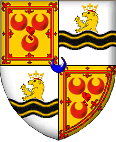|
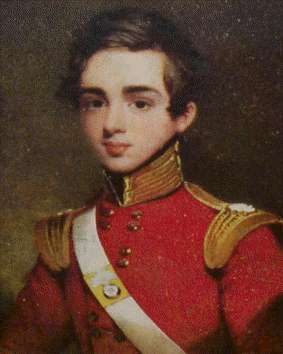
Alexander Seton, 5th of Mounie
(of the second family), was born at Mounie in Aberdeenshire
on 4 Oct. 1814, was the second but eldest surviving son of
Alexander Seton of Mounie and Janet Skene Ogilvy of Airlie,
daughter of Skene Ogilvy, D.D., minister of Old Machar,
Aberdeenshire.
Alexander was educated at home until the age of fifteen
until being sent abroad for his education in France and
Italy, and he studied mathematics and chemistry for some
months under Ferdinando Foggi at Pisa. On 23 Nov. 1832 he
was gazetted second lieutenant in the 21st or royal North
British fusiliers, and next year he was sent with part of
his regiment to the Australian colonies. He returned to
Scotland on leave in 1838, and was promoted to a first
lieutenancy on 2 March. He rejoined his regiment in India,
and received a company on 14 Jan. 1842.
Shortly after he exchanged into the 74th, he was stationed
at Chatham, and there he studied for two years in the senior
department of the Royal Military College, and in November
1847 received a first-class certificate. In 1849 he
proceeded to Ireland as assistant deputy
quartermaster-general of the forces there. He held this post
till 24 May 1850, when he was promoted to a majority.
On 7 Nov. 1851 he obtained the rank of lieutenant-colonel,
and about the same time was ordered to take command of the
drafts destined for the Cape of Good Hope, where his
regiment was engaged in the Kaffir war. He sailed in the
steam troopship Birkenhead, which on the morning of 26 Feb.
1852 struck on a rock in False Bay, twenty miles south of
Cape Town, and foundered in little more than ten minutes.
Seton was almost instantly known for his leadership and
command, and his gallant actions during the sinking of the
HMS Birkenhead in 1852.
The Birkenhead, an iron paddle ship, had sailed from
the Cove of Cork in Ireland with 634 people on board, most
of them soldiers, some with their wives and children, bound
for action in the Frontier War against Kaffir and Hottentot
tribesmen in the Cape of Good Hope. Lt-Col Seton was the
senior officer on board, in charge of detachments from ten
British regiments. The vessel was in the command of
experienced Royal Naval Captain Robert Salmond.
In spite of the sudden nature of the catastrophe, Seton
issued his orders with perfect calmness. The scene is said
by an eyewitness to have resembled an embarkation, with the
difference that there was less confusion. The boats could
only contain the women and children, and out of 634 persons
445 were lost, Seton himself being killed by the fall of
part of the wreck.
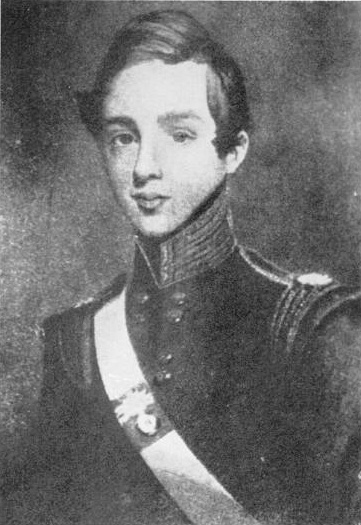 1096 Sergeant David Andrews " S ", later
Staff Sgt Major of the 60th KRRC (now the Royal Greenjackets),
wrote a letter to Mr. David Seton, brother of Colonel Alexander
Seton, the senior Army Officer on board the vessel, describing the
gallantry displayed by Colonel Seton: 1096 Sergeant David Andrews " S ", later
Staff Sgt Major of the 60th KRRC (now the Royal Greenjackets),
wrote a letter to Mr. David Seton, brother of Colonel Alexander
Seton, the senior Army Officer on board the vessel, describing the
gallantry displayed by Colonel Seton:
"Lt Colonel Alexander Seton
of Mounie, Aberdeenshire. Senior Army Officer aboard ship.
Was on his way to command the 74th of Foot in the 8th Frontier War
1846-1858.
A fine Officer who controlled the men aboard the ship
so that the women and the children would get away first, he also
delayed the men from swimming for their lives, until the life
boats had rowed well away from the side of the ship.
Lieutenant-Colonel Seton, whose
high-mindedness, self-possession, and calm determination inspired
all on board, was son and heir of the late Alexander Seton, Esq.
of Mounie, Aberdeenshire, and represented the Mounie branch of the
old and eminent Scottish house of Seton of Pitmedden, of the
Seton's of Meldrum family line.
His death was
undoubtedly a great loss to the British army, as all who knew him
agree in stating that he was a man of high ability and varied
attainments; he was distinguished both as a mathematician and a
linguist.
Lord Aberdare (formerly the Right Honourable H.
A.
Bruce) speaks of Colonel Seton, from personal knowledge, as "one
of the most gifted and accomplished men in the British army."
From
the wreck and
from Lieutenant Colonel Seton, came the naval protocol:
"Women
and Children First".
This disaster started the protocol of "women and
children first!", which became a standard evacuation
procedure in maritime disasters, although the phrase
was not coined until 1860. Similarly, " Birkenhead
Drill" carried out by soldiers became the epitome of
courageous behaviour in hopeless circumstances. The
phrase appears in Rudyard Kipling's tribute to the
Royal Marines, "Soldier an' Sailor Too":
To take your chance in the thick of a rush,
with firing all about,
Is nothing so bad when you've cover to 'and, an'
leave an' likin' to shout;
But to stand an' be still to the Birken'ead
drill is a damn tough bullet to chew,
An' they done it, the Jollies -- 'Er Majesty's
Jollies -- soldier an' sailor too!
Their work was done when it 'adn't begun; they
was younger nor me an' you;
Their choice it was plain between drownin' in 'eaps
an' bein' mopped by the screw,
So they stood an' was still to the Birken'ead
drill, soldier an' sailor too
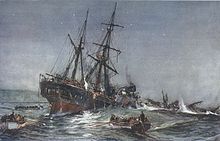 As
Captain Salmond rushed on deck, he ordered the anchor to be
dropped, the quarter-boats to be lowered, and a turn astern to
be given by the engines. However, as the ship backed off the
rock, the sea rushed into the large hole made by the collision
and the ship struck again, buckling the plates of the forward
bilge and ripping open the bulkheads. Shortly, the forward
compartments and the engine rooms were flooded, and over 100
soldiers were drowned in their berths. As
Captain Salmond rushed on deck, he ordered the anchor to be
dropped, the quarter-boats to be lowered, and a turn astern to
be given by the engines. However, as the ship backed off the
rock, the sea rushed into the large hole made by the collision
and the ship struck again, buckling the plates of the forward
bilge and ripping open the bulkheads. Shortly, the forward
compartments and the engine rooms were flooded, and over 100
soldiers were drowned in their berths.
The surviving soldiers mustered and awaited their officers'
orders. Salmond ordered Colonel Seton to send men to the chain
pumps, and sixty were directed to this task, sixty more were
assigned to the tackles of the lifeboats, while the rest were
assembled on the poop deck in order to raise the forward part of
the ship.
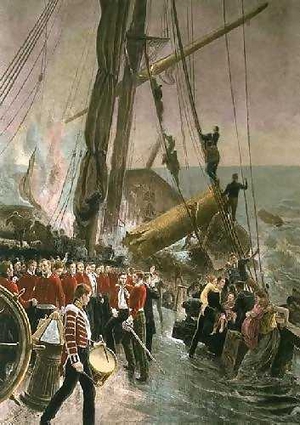 Seton
issued the command
declaring, Seton
issued the command
declaring,
"Gentlemen would you please be kind enough to preserve order
and silence amongst the men and ensure that any orders given
by Capt Salmond are instantly obeyed?",
"the women and
children first",
and then the 6ft 3in, 38-year old stood by the gangway as
the seven women and 13 children were put aboard the ships
cutter, which
lay alongside.
Two other boats were manned, but one was
immediately swamped and the other could not be launched due
to poor maintenance and paint on the winches, leaving only
three boats available. The two large boats, with capacities
of 150 men each, were not among them.
The surviving officers and men assembled on deck, where
Lieutenant-Colonel Seton of the 74th Regiment of Foot took
charge of all military personnel and stressed the necessity of
maintaining order and discipline to his officers. Almost
everybody kept silent, indeed nothing was heard, but the kicking
of the horses and the orders of Salmond, all given in a clear
firm voice.
Ten
minutes after the
first impact of the Birkenhead, the engines still turning
astern, the ship struck again beneath the engine room, tearing
open her bottom. She instantly broke in two just aft of the
mainmast. The funnel went over the side and the forepart of the
ship sank at once. The stern section, now crowded with men,
floated for a few minutes before sinking.
Just before
she sank, Salmond called out that "all those who can swim jump
overboard, and make for the boats".
Colonel
Seton however, recognizing that rushing the lifeboats would
risk swamping them and endangering the women and children,
issued the counter-order and, his sword drawn, ordered the
men to stand fast:
"You will swamp the cutter containing the women and
children. I implore you not to do this thing and I ask you
all to stand fast". Seconds later the Birkenhead
broke her back, not a man disobeyed Lt-Col Seton's orders
and they shook hands and said goodbye as the water closed in
over their heads.
Only three men defied and made the
attempt. The
cavalry
horses were freed and driven into the sea in the hope that
they might be able to swim ashore.
The
soldiers did not move, even as the ship broke up barely
20 minutes after striking the rock. Some of the soldiers
managed to swim the 2 miles (3.2 km) to shore over the next
12 hours, often hanging on to pieces of the wreck to stay
afloat, but most drowned, died of exposure or were taken by
sharks.
A number of sailors were court
martialled as a result of the accident. The court was
held on 8 May 1852 on board HMS Victory in Portsmouth,
and attracted a great deal of interest. However as none
of the senior naval officers of the Birkenhead
survived, no-one was found to be to blame. Captain
Edward WC Wright of the 91st Argyllshire
Regiment told the court martial:
The order and regularity
that prevailed on board, from the moment the ship
struck till she totally disappeared, far exceeded
anything that I had thought could be affected by the
best discipline; and it is the more to be wondered
at seeing that most of the soldiers were but a short
time in the service. Everyone did as he was directed
and there was not a murmur or cry amongst them until
the ship made her final plunge – all received their
orders and carried them out as if they were
embarking instead of going to the bottom – I never
saw any embarkation conducted with so little noise
or confusion.
In 1895 a lighthouse was erected
at Danger Point to warn shipping of the dangerous reef.
The lighthouse is about 18 metres (59 ft) tall and is
visible for approximately 25 nautical miles (46 km). In
1936, a remembrance plate for the Birkenhead was affixed
to its base by the Navy League of South Africa. A new
Birkenhead memorial was erected nearby away in March
1995. In
December 2001, the plaque was moved closer to the
lighthouse.
A memorial in St. Giles'
Cathedral in Edinburgh bears the following inscription:
In memory of Lieut.-Colonel
Alexander Seton, Ensign Alex. C. Russell, and
forty-eight N.C.O.s and men of the 74th Highlanders
who were drowned at the wreck of H.M.S. 'Birkenhead'
on the 26th February 1852, off Point Danger, Cape of
Good Hope, after all the women and children on board
had been safely landed in the ship's boats.
Frederick William IV of Prussia
recognized the bravery of the soldiers and ordered an
account of the incident to be read at the head of every
regiment in his army, while Queen Victoria ordered the
erection of an official Birkenhead monument at the
Chelsea Royal Hospital.
In 1892, Thomas M. M. Hemy
painted a widely admired maritime depiction of the
incident, "The wreck of the Birkenhead". Prints of this
painting were distributed to the public. In 1977, the
South African mint issued a "Heroes of the Birkenhead
Medallion" gold coin commemorating the 125 years since
the sinking, featuring Hemy's painting on one of the
faces of the coin. The
original Thomas Hemy
picture of the Birkenhead shows Colonel Seton drawing up his
Officers and Men on deck to the sound of a Drummer, with the women
and children being assembled on the deck prior to being loaded
into a lifeboat. There is a smaller copy of this picture in
the Williamson Art Gallery and Museum in Birkenhead.
The
heroism displayed by Seton and the rest of those on board the
Birkenhead was also commemorated by Sir Francis Doyle in a poem
on ‘The Loss of the Birkenhead,’ in ‘The Return of the Guards
and other Poems’ (1866; cf.
R. L. Stevenson,
Essay on Admirals, and
Rudyard Kipling,
Seven Seas).
[A Short Memoir of Alexander Seton,
1854; Burke's Landed Gentry, 6th edit.; Annual Register, 1852,
pp. 470–2; Notes and Queries, 8th ser. ix. 492; Cornhill Mag.
February 1897.]
Three placenames in the Canadian
province of British Columbia were conferred in honour of
the Birkenhead disaster by Hudson's Bay Company explorer
Alexander Caulfield Anderson, a boyhood friend and
cousin of Lt-Col. Seton of the 74th Regiment of Foot, on
a traverse of uncharted country between the Fraser
Canyon and the coastal Lower Mainland in 1846. Named
after his cousin, SETON LAKE cuts west through the Coast
Mountains from the Fraser Canyon town of Lillooet,
beyond which is its twin Anderson Lake.A few miles
southwest from the head of Anderson Lake is Mount
Birkenhead, on the north side of the low pass connecting
the valley of those lakes to that of the Birkenhead
River. The river, the valley area near Mount Birkenhead
known as Birken and Birken Lake at the summit of the
pass were named after the mountain, and not directly by
Anderson.
Lt-Col Seton
died unmarried, and the Estate of Mounie passed to his
younger brother, David.
|






